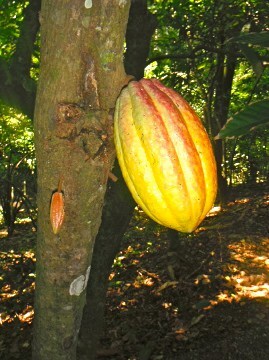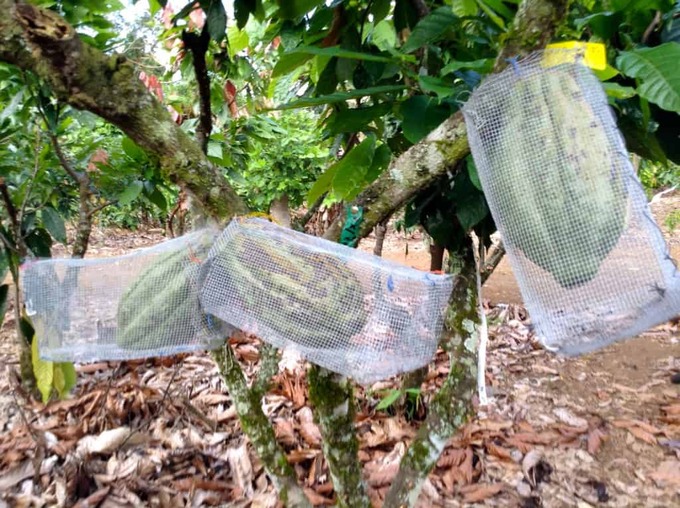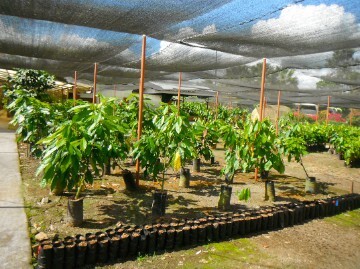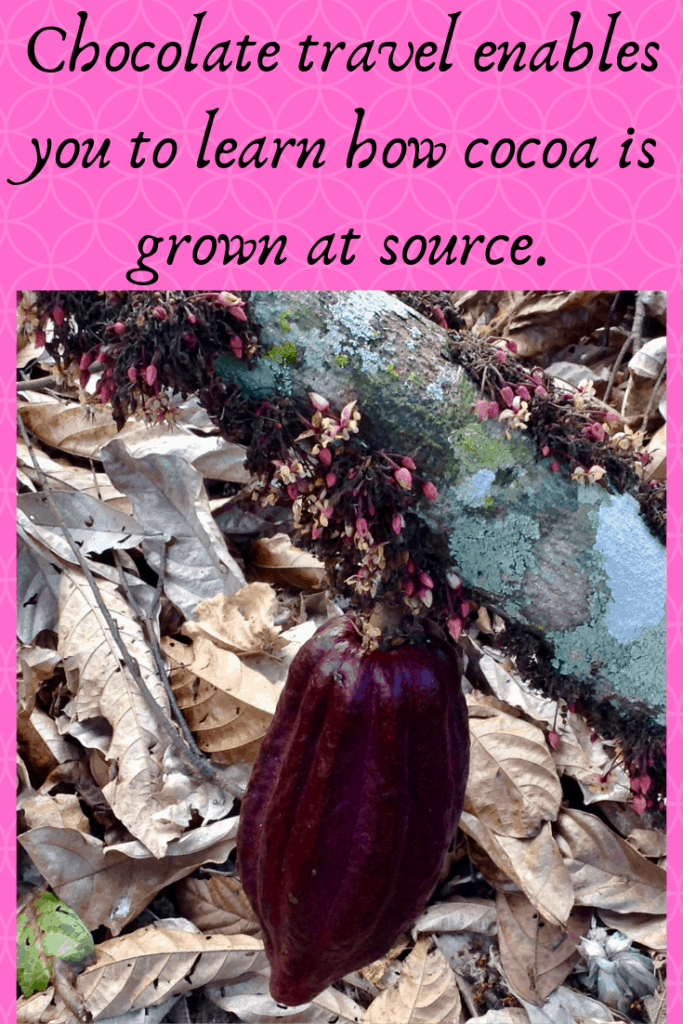Have you ever thought about where the cocoa comes from that is used to make our beloved chocolate? Or what it’s like to grow cacoa? Having now seen cacao growing in a number of distinctly different regions, I can answer that, and would like to share what I learned on a trip to Costa Rica.

We saw how the Chinese Rose Beetle has been devastating cacao plantations in Hawaii. We saw how rats are a problem in St. Lucia, ants are the primary culprits in Peru, and black pod rot has been a problem for cacao growers in Ecuador.

There are also many challenges when it comes to growing cacao in Costa Rica. I visited CATIE (the Tropical Agricultural Research and Higher Education Center) while in this lush Central American country and learned that the experts are finding ways to fight disease and help the cocoa survive and thrive. The netting that surrounds the pods in the photo above helps trap the humidity on diseased pods so that the scientists can isolate the fungus and study it.

The disease known as Frosty Pod Rot or more formally called Moniliasis Disease has long been devastating cocoa plantations in Costa Rica and 12 other countries in tropical America including Mexico. But some progress has been made to battle the disease via ongoing research.

CATIE has been studying cacao’s genetic makeup and attempting to develop hybrids of cacao that will be more resistant to disease. I was privileged to be invited to the 70th anniversary celebrations of CATIE and learned much from speaking to the cacao growers and agricultural experts who were present.
In addition to disease, the cocoa plantations battle rodents such as squirrels who like to chew at the pods in order to get to the nectar inside. By planting coconut and guava trees among the cacao, farmers are able to divert the squirrels’ attention and have them disturb other produce that is less valuable and easier for the rodents to get at. It’s not easy outsmarting the squirrels, as many of us know in attempting to divert them from our birdfeeders!

We all love to eat fine chocolate, but until I began my research, I had no idea how difficult it is to grow the cacao that ultimately becomes our beloved chocolate. No wonder artisanal chocolate is so expensive! The finest quality aromatic cocoa comes from Criollo and Trinitario cacao trees that unfortunately are the most susceptible to disease and intruders.
I hope you enjoyed learning about the challenges facing the cocoa growers of Costa Rica. There are different challenges that affect growing cacao in every country. But the determination and innovative techniques used by each country show that positive results can indeed be achieved.

Costa Rica’s ideal climate and rich soil make it the perfect environment for growing cacao. With its lush rainforests and tropical weather, cacao cultivation thrives, contributing to Costa Rica’s reputation for producing high-quality chocolate. Embracing sustainable practices, Costa Rican cacao farmers play a vital role in preserving the ecosystem while delivering exquisite chocolate to the world. #CostaRica #Cacao #SustainableFarming
I learned so much from this article about growing cacao in Costa Rica. I can’t wait to share this post with others. Thanks for all the work you do in putting together this site.
Your writing is a source of inspiration for aspiring writers. Thanks for this insightful post about how to grow cacao. I am very interested in growing things.
Thanks for this very interesting discussion! My wife and I just purchased a small finca near San Isidro in Costa Rica. It was an organic coffee farm but has been abandoned for many years. The elevation is about 1000 meters. A neighbor has wild cacao trees that seem healthy, but nobody knows anything about them. We would like to remove the coffee (7 acres) and replace it with cacao. Could you recommend someone to talk with before we begin? Gracias!
Hi Nyle and thanks for your comment. If you email me at pendor@mts.net I can put you in touch with some folks who can help you out.
Hi Nyle, are you still at your finca, I’d love to know how you got on. We have just moved to near San Isidro and bought a 16 acre place in El Roble, also 1000 metres. The land is half forest and half pasture as the previous owners were horse mad. It is going to be a tough job to convert all that pasture into something more interesting so I’m curious to know if you went with cacao and removed your coffee. I am trying to find out which cacao can grow at 1000ft. Regards, Red
Hello Red. You may wish to redirect your reply to Nyle at tioli@fastmail.fm as I don’t know if they have clicked the box to receive replies to their comment. Cheers and thx for being a reader of Chocolatour.
Doreen, all of the small chocolate makers of Costa Rica felt blessed when you came to visit us last year in Puerto Viejo. We feel that we have something special to offer, plenty of dedicated craft masters doing their best to produce and present the best in vibrant and fresh single estate chocolate bars! The problems you highlight are and will always be the main concern of any grower, and if you make the choice of going 100% organic you also know it will hurt your bottom line because it means you will need to invest in a lot more man hours to maintain your chocolate forest healthy and free of diseases. You mentioned Guava and Coconut trees as a diversion for the squirrels, woodpeckers, night monkeys etc. My impression is that you want to leave even more acreage for tress like mango, citrus, papaya and others to feed those wonderful competitors – and remember – the higher biodiversity in the chocolate forest environment, the richer your cacao may just be when it comes to flavor and depth. Monochromatic plantations (not just in cacao) are not environmentally sustainable. I understand and highly appreciate Juan Pablo’s main concern about making it economically sustainable for the farmers (which is a must!) rather than 100% organic, but I think we all have a task ahead of us as professionals and educators – we need to share the knowledge of the challenges and subsequently the costs of making the product that the customers ideally want – and make sure they feel it is fair to pay for it too.
Thanks so much for your very thoughtful comment, Henrik. The rationale you cite is precisely the reason I wrote this post. I really want chocolate lovers to understand the challenges cocoa growers face so that they better understand why good quality is so expensive. And you are so right. The cacao definitely does pick up the flavours of the other plants growing on the land. Terroir is a major factor in the flavour development of cocoa and I love that! Thx again for sharing your thoughts and expertise.
well, its an interesting blog….
Interesting post Doreen! I was just in Grenada where cacao production is one of their main industries. I didn’t notice a problem with pests at the organic plantation I visited but wish I had asked about how they have avoided what seems to be a very serious problem. Let me know when you plan to go to Grenada and i can put you in touch with the producers I met – I’m sure they’d love to meet you.
Thx, indeed, Michele. I do have intentions to visit Grenada as they are producing some delicious chocolate. If you recall in my book, the Grococo Bar–made from Grenadian cocoa by Rococo Chocolatier of London–won my award for the most aromatic bar. It was truly delicious!
I recently came back from my trip in Bali, where I happened to visit coffee and cocoa fields with samples tasting. I also saw cocoa pods for the first time and was wondering, if it would be possible to grow some in Central Europe in my apartment, what do you think?
Absolutely not, Milan! You could likely grow cocoa seedlings indoors, as I know a chocolate maker in San Francisco who is doing that. But the cacao tree does not produce cocoa pods until it is several years old and quite large. And they only grow under very limited conditions (hot and damp for the most part) so Central Europe definitely doesn’t cut the bill!
Really interesting information. Knew some of it but have to admit I had never seen a picture of cocoa pods before.
Hi Catarina. I’m surprised you don’t recall previously seeing a photo of cocoa pods before as you are a long-time reader of this blog and I’ve posted many. Perhaps the solitary pod in this pic strikes you differently as it is more cylindrical in shape, as compared to the more tubular shape of some of the pods I’ve photographed before. Thx as always for your visit and comment.
Insects,, fungus, rodents, and many other issues plague food crops and those plants used to make our delicious chocolate. I am not sure that creating hybrids is the answer though.
Hi Cheryl and thx for your comment. Actually, most of the good chocolate you eat today is the result of a hybrid! Most chocolate used by today’s artisan chocolatiers and chocolate makers is of the Trinitario varietal of cocoa. That is a hybrid invented in Trinidad that blended the expensive, rare and high-coveted Criollo cacao from South and Central America with the commonly grown commercial-grade Forestero from Africa. The existence of Trinitario transformed the world of fine chocolate and made it much more accessible to chocolate loving consumers.
I visited the cacao plantations in Cuba, but I wasn’t fortune enough to find out more about the difficulties faced, so thanks very much for sharing this little insight. It will definitely make me think more when I am enjoying some fine chocolate! 🙂
Thx very much for your comment, Cyra. I’ve been to Cuba a few times, but not recently, so I haven’t investigated chocolate there – yet. The Cuban chocolate I recall tasting was not that great. Did you find any really good Cuban chocolate on your travels?
Hola from Talamanca Organica Cacao & Fine Chocolate. I have been stewarding my Caribbean Costa Rica cacao farm located in Puerto Viejo Talamanca for the past 20 years and have been battling these diseases that you mention in your blog. Even after many years of maintenance, we still have recurrences of Moniliasis and black pod rot, and rust rot, as well as witches broom. The climate plays a critical part in what percentage of any crop is frought with disease. For instance, in 2013 we had a huge year, with little disease. 2013 was a dry year, with below average rainfall. In 2014 we started off the year very dry, hence, in half a year we produced 300 dried kilos on our 14 acre farm; however, by May of 2014 came heavier rains than usual, and we lost most of the fruit on the trees to disease, and only produced 150 dried kilos the remainder of 2014. We witnessed the trees flower heartily, set 20 plus fruit on a tree, and then in a week of solid rain, they all turned black or if they were bigger, had “frosty pods.”
We have experimented with numerous organic practices (being that we are exclusively organic), and have found success in minimizing the pod rot with the use of OpenAll SOS (http://www.deutrel.com/openall-sos-overview.php) which has been shown through research in cacao production to reduce the amount of pod rot, especially when used as a folier feeder. We plan to continue with this in conjunction of maintaining the trees cleaned and groomed. The cacao tree is very sensitive and needs to be tended to regularly by removing suckers and extra limbs and creating a favorable midge habitat will allowing for air flow and sun penetration. A delicate balance in deed. Additionally we have combined the use of Biochar, which involves creating carbon from fallen tree wood and applying the carbon to the tree drip line. Biochar is more than a soil amendment, it is a soil catalyst, which means that creates a permanent habitat for favorable microorganisms as well as building soil structure. Biochar practices that occurred thousands of years ago are what made the Amazon, “the Amazon.” If you research the Amazon, you see that below the soil are hundreds of hectares wide of biochar. It has been speculated that it was from burning to make pottery, but truly it is a mystery to us modern humans as to why lies below the Amazon a layer of biochar. Today, we reap the benefits of our ancestors. And here at Talamanca Organica Cacao and Fine Chocolate, that is our focus, the future generations of cacao to come. Viva the Cacao, Viva la Chocolate!
Thank you Doreen for joining us in Puerto Viejo Talamanca Costa Rica, and we anticipate your swift return to share more chocolate together. Pura vida! In Joy, from the cacao farm of Talamanca Organica.
Please feel free to visit us on Facebook as well as to inquire in the purchase of our artisan cacao beans and chocolate.
Christina, Thx so much for sharing your personal insights on growing cacao in Costa Rica. I would love to come and visit you again soon. Let’s plan to launch Volume II of Chocolatour in Puerto Viejo!
Wow, what an educational little piece!
Costa Rica is obviously somewhere we’ve been incredibly recently, so it felt even more relevant personally! 🙂
Day 1 in Ecuador today, sounds like we need to sample a little chocolate here as well!
Absolutely, Chris! Ecuador has some amazing chocolate. Just search this blog for some suggestions! And enjoy your travels in South America!
Planting coconut and guava trees to divert the squirrels is clever. Too bad other issues aren’t as easily dealt with.
Hi Doreen,
I never really thought about where the chocolate comes from before! I mean, I knew it came from cacao, but never knew what cacao looked like. I’ll be touring a chocolate factory in April in Guadeloupe, so hopefully I’ll get a first-hand look. I always enjoy reading your posts!
Thanks so much for the words of encouragement, Rachel. It means a lot to me to know that people are enjoying–and learning from–my posts. What factory will you be touring in Guadeloupe? Please let me know how it goes. Thx and have a great time!
It’s Les Supremes in Vieux Habitants. I haven’t arranged it yet, but I’m hoping to take a tour. I’ll let you know! There’s also a Musee de Cacao, but I’ve read mixed reviews of that one.
Superb, Rachel! I’ve bookmarked their site in the event I ever make my way to Guadeloupe!
It’s important to know where our food comes from and what happens to it in it’s place of origin. Most people don’t think about that when they’re unwrapping a chocolate bar. Thanks for sharing this Doreen!
Thx for your comment, Tracie. Yes, I think an increasing number of people are concerned with the origins of the food they eat. Has it been produced in an eco-friendly way? Have the growers rec’d a fair compensation for their product and effort? At least with chocolate, you can usually identify those concerns by the labelling. Look for the words “Sustainable,” “Fair Trade,” and/or “Organic” on the wrapper of your chocolate bar and you’re off to a good start!
Doreen, thank you very much for your report that certainly reflects some of the concerns of cocoa farmers. Pests are one of the threats faced by farmers to stay productive, along with shade management, preventive activities, nutrition, selection of genetic material, among other fronts. Productivity is the key factor.
With high yields, the traditional agroforestry production method of cocoa cultivation allows producer families to have a potentially respectable income from the sale of cocoa beans, timber products and fruit trees, while alleviating the poverty that is typical of the cocoa producing areas.
Thanks so much for joining the conversation, Juan Pablo. For those who don’t know, Juan is the owner of Nahua Chocolate based in San Jose and he grows cacao in the Upala region of Costa Rica. I will be profiling Nahua in a future post on this blog.
Juan explained to me how important it is for people to buy chocolate that is marked “Sustainable” as that means the cacao is being grown in an ecologically friendly way, and that the growers are realizing a fair return from their labour. Throughout my chocolate travels, I have been extremely grateful to people like Juan who have taken the time to try and explain the important issues to me. Chocolatour is definitely not just about eating or reviewing chocolate!
Thanks for sharing Doreen. We’ve also had rains this year that knocked off a lot of flowers so the first part of this years harvest looks like it might be a bit thin. But, we are grateful to live in the cacao forest and enjoy artisan chocolate made right here on the farm. Stay warm!
Jeff g.
Thx so much for joining the conversation, Jeff. For those who don’t know Jeff, he owns the land on which the fabulous Mango Walk guesthouse that I’d stayed at is located. And on that same property, are the cacao trees on which Paul Johnson makes his artisan Caribeans Chocolate. There are posts on both the Mango Walk and Caribeans in our archives.
Yes, Jeff. I remember it being quite wet when I was there for the Chocolate Fest. Sorry to hear you’ve had heavy rain that might have knocked those delicate cocoa blossoms from the trees. We chocolate lovers are pulling for you!
I remember reading about some of these challenges in your book, Doreen. But this sure does explain the expense of artisanal chocolate! As to the squirrels…seems they wreak havoc everywhere, but they are really devastating in this sense!
Hi Jacquie & thx for your comment. It’s funny. I never actually saw a squirrel while in Costa Rica despite being on plantations and in the jungle pretty much my whole time there. they must be more allusive than our North American squirrels, who are here, there, and everywhere!
Hi Doreen, I enjoyed this post and brought back memories of reading your book Chocolatour where some of the problems were described. Growers of any kind of product know there are challenges but somehow you never stop to think that growing cacao also does – definitely explains why chocolate is expensive.
Thx for your comment, Lenie. Yes, I think farmers are always prepared for challenges, but cacao seem to attract more than its share of challenges from weather, disease, and vermin. Thanks goodness that research is helping battle the problems.
Seems the cocoa attracts all sorts of vermin. Who knew? I personally suspect the squirrels get high chewing the cacao and envision them running off like crazed rats. Interesting post.
I love your imagination, Ken! Yes, I bet there might be some chemical compounds in that placenta that might get the brain cells pumping! Next thing you know, the squirrels will be snorting cocoa powder like the Canucks in Toronto & Vancouver.
Hi Doreen, I had no idea there are so many challenges involved in growing chocolate. Oh but its so worth it! Just hope those clever squirrels never figure out how yummy coconut and chocolate are together or we are in trouble. Haha! 🙂
Hi Susan. Yes, it’s quite amazing how cocoa growers in each country have such challenges to deal with. I’m grateful that so much research is going on to try and win the battles!
Definitely an eye opener for me. One a global social/ economic issue and two, I have so much appreciation with chocolates now. Thanks for sharing this.
Thx for your comment, Mahal, and welcome to the blog! It really is an eye opener when you visit plantations in other countries. Makes you appreciate the end product so much more.